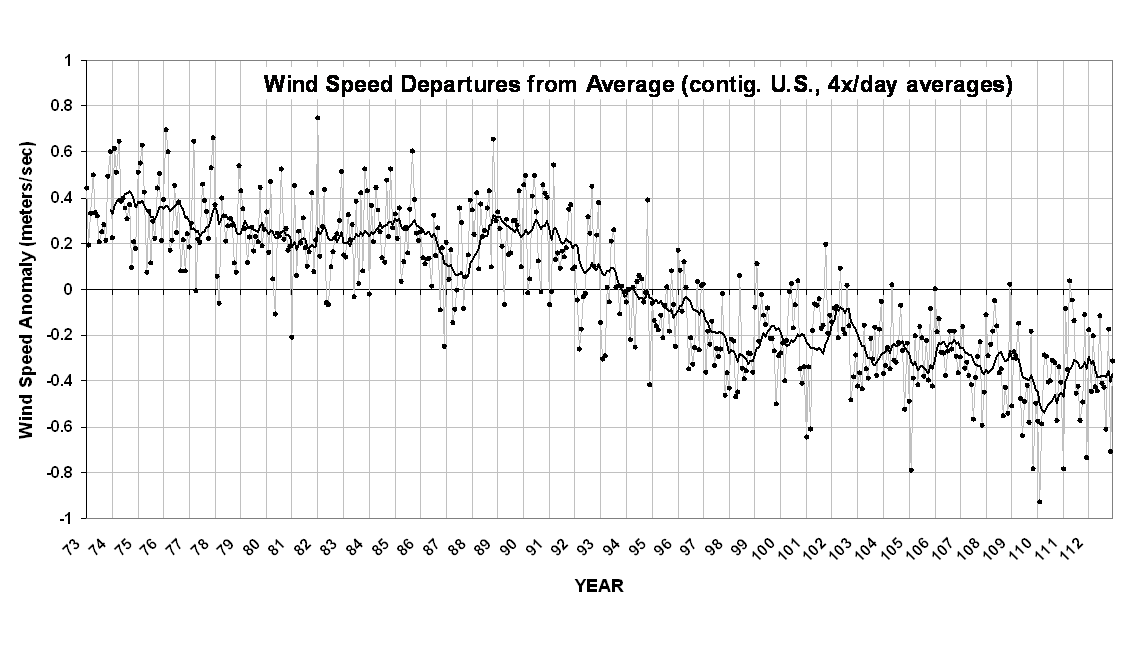I recently discussed the possibility that waste heat from our energy use could be contributing to the observed increase in surface air temperatures, since it potentially rivals the size of the radiative forcing expected from increasing CO2, at least where people live (and put thermometers).
Now I’d like to discuss another possibility, related to something which I’ve noted in the surface weather data over the U.S.: a decrease in average surface wind speed. Over the last 40 years, there has been an observed decrease in near-surface wind speeds of about 0.7 meters per second, which is about 1.5 mph, which is shown in the following plot based upon my analysis of raw hourly ISH data downloaded from NCDC (dots are monthly, solid line is trailing 12-month average; click for large version):
Now, there are 3 basic ways in which land surface temperatures can warm: (1) an increase in absorbed sunlight; (2) a decrease in the rate at which the surface loses infrared (IR) energy, and (3) a decrease in convective heat loss from the surface.
That convective heat loss is made up of both dry and moist convective air currents. For example, dry convection would dominate over the desert; moist convection dominates over the ocean. Together, it is estimated that surface convective heat loss over the Earth averages around 100 Watts per sq. meter….much higher in the tropics, lower toward the poles.
Now, it is well known that convective heat loss is roughly proportional to surface wind speed. A wind decrease of 1.5 mph since the 1970s would represent about a 10% reduction in convective heat loss, which is about 10 W/m2 (all back-of-the-envelope, mind you, taking into account that there is still convective heat loss even when the wind goes to zero on a sunny day…it’s complicated).
Now, the 10 W/m2 is about 10 times larger than the estimate remaining radiative imbalance from increasing CO2. In other words, in some sense, it’s ten times easier to blame increasing U.S. temperatures on decreasing wind speed than on increasing CO2.
Of course, there are a number of caveats, not the least of which, Is the observed decrease in wind speed real?
Globally, more frequent El Nino’s in recent decades also decrease wind speeds over the ocean, which leads to a reduction in convective heat transport. But, the higher ocean surface temperatures (primarily from reduced upwelling of cold water) tend to counteract this by evaporating more water into the lower atmosphere, which can fuel stronger convection. So, there are competing influences which make the problem more difficult to analyze over the ocean.
But all other things being equal, a decrease in wind speed leads to decreased convective heat loss, which then leads to higher higher surface temperatures.
So, what then limits the value of those higher surface temperatures? Well, at 25 deg. C, an increase of 1 deg. C leads to an increase in infrared radiative loss by 6 W/m2. So, if decreased winds were to cause surface warming, the surface produces an extra boost in IR cooling which then limits the temperature rise. A change in one portion of the energy budget tends to result in changes in other components of the energy budget.
I don’t have a strong opinion regarding how much decreased surface winds (or waste heat production) have contributed to U.S warming in recent decades. Maybe a little, maybe most of it. We just don’t know.
But I do have a strong opinion about scientists who have a tendency to interpret every change they see in nature as some sort of response to increasing CO2.
NOTE: I anticipate someone is going to make a comment to the effect that convection will always stay the same in order to maintain the tropospheric temperature lapse rate. This is not true. Every day that it is sunny over land, the lapse rate in the lowest 100 meters of the atmosphere is strongly super-adiabatic. This is because convective air currents cannot transport heat from the solar-heated surface to the free atmosphere as fast as it is being generated; the process is rather slow and inefficient, and the strength of turbulent mixing by the wind does make a difference. And the hotter the surface gets under low wind conditions, the more energy the surface then loses instantaneously through infrared radiation, rather than through convection. Many field experiments in the last 50+ years have made observations of the dependence of convective heat loss on wind speed.

Comments
194 responses to “Decreased Surface Wind as a Contributor to Warming”